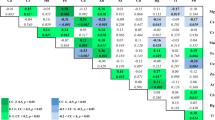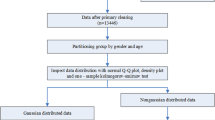Abstract
Aim
Physiological concentrations of some elements fluctuate during pregnancy due to the increased requirements of growing fetus and changes in the maternal physiology. The aim of the study is to evaluate the distribution at different stages of pregnancy in healthy Chinese women and to show the association between trace elements and gestational age-specific reference intervals.
Methods
A cross-sectional study was performed in 1089 pregnant women and 677 nonpregnant control women. Five element concentrations, including Cu, Zn, Ca, Mg, Pb in the blood were determined by atomic absorption spectrometry. Spearman’s rank correlation test was used to assess the relationship between weeks of gestation and blood element concentrations.
Results
The mean levels of Cu and Mg were 23.64 ± 4.69 μmol/L and 1.36 ± 0.12 mmol/L, respectively, in the control women. While 0.68 % of all pregnant women showed Cu levels below the normal ranges, the levels of Mg were comparable in different groups. Though the overall mean blood zinc and Ca concentrations (83.84 ± 17.50 μmol/L and 1.60 ± 0.15 mmol/L, respectively) increased gradually with the progress of gestation, the Zn and Ca deficiency levels (16.6 and 3.6 %, respectively) decreased with the advance of gestation. Compared with nonpregnant group, the concentrations of Cu, Zn, Ca, Mg, Pb during the different stages of pregnancy, as a whole, were significantly different. Positive correlations were observed between weeks of gestation and blood Cu, Ca, Pb concentrations (r = 0.301, 0.221, 0.223; P < 0.05). There was a negative correlation blood Mg concentrations and weeks of gestation (r = −0.321; P < 0.05). A weak positive correlation was noted between Zn concentrations and weeks of gestation (r = 0.125; P < 0.05).
Conclusion
The importance of Cu and Mg deficiency and supplementation is well realized, but, Zn/Ca deficiency and Pb exposure is still exist; the overall deficiency of pregnant women was not so optimistic. During pregnancy, the established reference values will provide an important guidance for the reasonable supplementation of essential elements and surveillance of lead overexposure.
Similar content being viewed by others
References
Trace elements in human nutrition (1973) Report of a WHO expert committee. World Health Organ Tech Rep Ser 532:1–65
Failla ML (2003) Trace elements and host defense: recent advances and continuing challenges. J Nutr 133:1443S–1447S
Van-Mierlo LA, Arends LR, Strepper MT et al (2006) Blood pressure response to calcium supplementation: a meta-analysis of randomized controlled trials. J Hum Hypertens 20:571–580
Hofmeyr GJ, Duley L, Atallah A (2007) Dietary calcium supplementation for prevention of pre-eclampsia and related problems: a systematic review and commentary. BJOG 114:933–943
Pathak P, Kapil U (2004) Role of trace elements zinc, copper and magnesium during pregnancy and its outcome. Indian J Pediatr 71:1003–1005
Wang J, Zhu H, Yang Z, Liu Z (2013) Antioxidative effects of hesperetin against lead acetate-induced oxidative stress in rats. Indian J Pharmacol 45:395–398
Ghiasvand M, Aghakhani K, Salimi A et al (2013) Ischemic heart disease risk factors in lead exposed workers: research study. Occup Med Toxicol 228:11–14
Scinicariello F, Abadin HG, Murray HE (2011) Association of low-level blood lead and blood pressure in NHANES 1999–2006. Environ Res 111:1249–1257
Maia PA, Figueiredo RCB, Anastacio AS et al (2007) Zinc and copper metabolism in pregnancy and lactation of adolescent women. Nutrition 23:248–253
Hansen S, Nieboer E, Sandanger TM et al (2011) Changes in maternal blood concentrations of selected essential and toxic elements during and after pregnancy. J Environ Monit 13:2143–2152
Papanikolaou NC, Hatzidaki EG, Belivanis S et al (2005) Lead toxicity update, a brief review. Med Sci Monit 11:RA329–RA336
Xu Y, Qiao Y, Cao H et al (2004) Epidemiological survey on lead concentration of blood for children 0–6 years in western Henan Province and its affecting factors. Chin J Child Health Care 2:28–31
Hu H, Tellez-Rojo MM, Bellinger D (2006) Fetal lead exposure at each stage of pregnancy as a predictor of infant mental development. Environ Health Perspect 114:1730–1735
Jelliffe-Pawlowski LL, Miles SQ, Courtney JG et al (2006) Effect of magnitude and timing of maternal pregnancy blood lead (Pb) levels on birth outcomes. J Perinatol 26:154–162
Zhan Z, Enwu Y, Junjie L et al (2013) Gestational age-specific reference intervals for blood copper, zinc, calcium, magnesium, iron, lead, and cadmium during normal pregnancy. Clin Biochem 46:777–780
Shen W, Zhang B, Liu S et al (2015) Association of blood Lead levels with methylenetetrahydrofolate reductase polymorphisms among Chinese pregnant women in Wuhan City. PLoS One 10:e0117366
US Centers for Disease Control (1991) Preventing lead poisoning in young children. US Centers for Disease Control, Atlanta
Perkins M, Wright RO, Amarasiriwardena CJ et al (2014) Very low maternal lead level in pregnancy and birth outcomes in an eastern Massachusetts population. Ann Epidemiol 24:915–919
Hertz-Picciotto I, Schramm M, Watt-Morse M et al (2000) Patterns and determinants of blood lead during pregnancy. Am J Epidemiol 152:829–837
Izquierdo Alvarez S, Castanon SG, Ml Ruata et al (2007) Updating of normal levels of copper, zinc and selenium in serum of pregnant women. J Trace Elem Med Biol 21(1):49–52
Keen C, Uriu-hare J, Hawk S et al (1998) Effects of copper deficiency on prenatal development and pregnancy outcome. Am J Clin Nutr 67:1003S–1011S
O’Brien KO, Zavaleta N, Caulfield LE et al (2000) Prenatal iron supplements impair zinc absorption in pregnant Peruvian women. J Nutr 130:2251–2255
Castillo-Durán C, Cassoria F (1999) Trace minerals in human growth and development. J Pediatr Endocr Metab 12:589–601
Alvarez SJ, Castanon SG, Ruata MLC et al (2007) Updating of normal levels of copper, zinc and selenium in serum of pregnancy women. J Trace Elem Med Biol 21:49–52
Hambidge K, Abebe Y, Gibson R (2006) Zinc absorption during late pregnancy in rural southern Ethiopia. Am J Clin Nutr 84:1102–1106
Tamura T, Goldenberg RL, Johnston KE et al (2000) Maternal plasma zinc concentrations and pregnancy outcome. Am J Clin Nutr 71:109–113
Tuttle S (1983) Trace element requirements during pregnancy. In: Campbell DM, Gillmer MDG (eds) Nutrition in pregnancy. Royal College of Gynaecologists, London, pp 47–54
Sheldon WL, Aspillaga MO, Smith PA et al (1985) The effect of oral iron supplementation on zinc and magnesium levels during pregnancy. Br J Obstet Gynaecol 92:892–898
Cherry FF, Bemnett EA, Bazzano GS et al (1981) Plasma zinc in hypertension/toxemia and other reproductive variables in adolescent pregnancy. Am J Clin Nutr 34:2367–2375
Mohapatra P, Mohapatra SC, Aggrawal DK et al (1990) Nutritional status of antenatal women in rural areas of Varanasi, Uttar pradesh. Man India 70:85–91
Liu J, Yang H, Shi H et al (2010) Blood copper, zinc, calcium and magnesium levels during different duration of pregnancy in Chinese. Biol Trace Elem Res 135:31–37
Acknowledgments
Authors thank Mr. Juan Shi, Technician, for his excellent help in the laboratory. All authors have made a significant intellectual contribution to the manuscript.
Author information
Authors and Affiliations
Corresponding author
Ethics declarations
Conflict of interest
None disclosed.
Additional information
K. Liu and X. Mao contributed equally to this work and should be considered co-first authors.
Rights and permissions
About this article
Cite this article
Liu, K., Mao, X., Shi, J. et al. Evaluation of lead and essential elements in whole blood during pregnancy: a cross-sectional study. Ir J Med Sci 185, 677–682 (2016). https://doi.org/10.1007/s11845-015-1339-9
Received:
Accepted:
Published:
Issue Date:
DOI: https://doi.org/10.1007/s11845-015-1339-9




